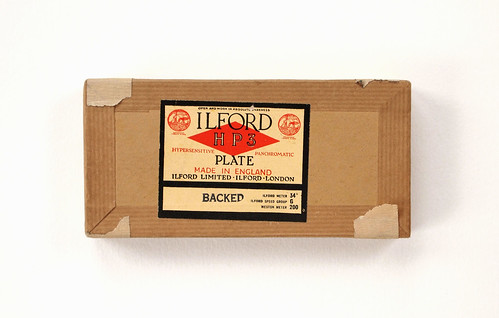 |
| Ilford HP3 6x13 plate box |
In my blog post
'A box of vintage plates and paper' I listed amongst the contents one of the HP3 boxes as "One box with 'paddle steamer' trademark, stereo plates 6x13cm (?) size." I have a box of identical dimensions of unopened Ilford Selochrome plates, which are labelled on the outer wrapping 6x13cm, a stereo plate format. However, opening the box in a dark bag to investigate, I found that the plates inside were rather shorter than the box suggested. I sacrificed one plate to the light to be able to measure it accurately. The plate was 6cm by 10.8cm, but had evidence of having been cut down or clipped by hand - one of the short sides had a rather rough edge (I'm actually surprised by how rough and haphazard the edges of some of the glass plates I've used has been). I imagine that the plates had been cut down in such a way that they could be fitted or used inside quarter-plate holders. I could have done this with my
Ensign Klito, but instead chose to make adaptors to use the HP3 plates in 5x4 inch plateholders, and shoot them with my
MPP Micro-Technical camera. I shot a first plate from this box without having made any tests, but having used HP3 plates of a similar age before, I thought that given a long enough exposure, I would get a result.
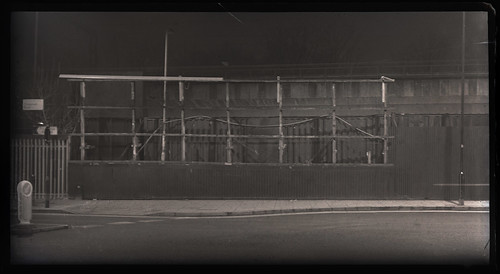 |
| 10.8x6cm HP3 plate, first exposure, MPP Micro-Technical Mk VI with 150mm Xenar |
I gave the plate a generous twelve-minute exposure with the lens wide open at f4.5. The resulting negative was perhaps over-exposed, but there was plenty of detail and, without any sources of light inside the frame, there were no blown highlights. Although shot using a tripod, there is a bit of camera shake: during the exposure, a car stopped directly in front of the camera and the driver leaned out to ask me directions to a well-known nearby shopping centre. During this exchange I had to keep the darkslide in front of the open lens to preserve the scene. As the plate didn't fit in my Combi-Plan tank, I simply dropped it into a Patterson 3-reel tank for stand development, with the emulsion side facing the tank's outside edge. I subsequently made a test but this wasn't entirely necessary: as I have found with some of the glass plates I've used, a combination of long exposures, inherent latitude, reciprocity law failure, and the compensating effect of stand development (plus some fog from age), all help to make for a large margin of error.
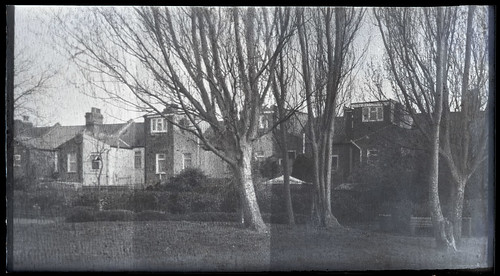 |
| 10.8x6cm HP3 test plate, MPP Micro-Technical Mk VI with 16.5cm Tessar |
I metered the plate for the test at 25, and made three exposures by progressively withdrawing the darkslide. On development, I found I'd loaded this plate back to front, with the anti-halation backing facing the lens and imparting a texture to the image. However, it was clear that the plates were still very usable, and I shot the rest of the plates over the next few weeks.
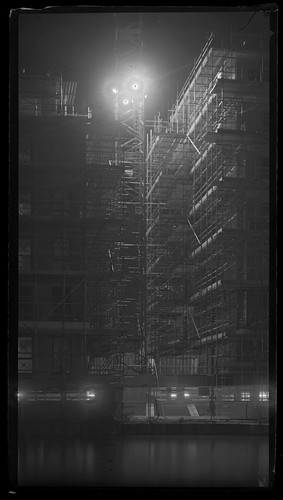 |
| HP3 plate, MPP Micro-Technical Mk VI with 16.5cm Tessar |
 |
| HP3 plate, MPP Micro-Technical Mk VI with 150mm Xenar |
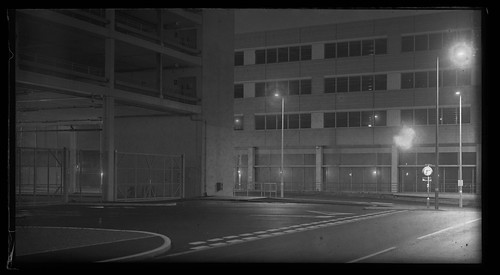 |
| HP3 plate, MPP Micro-Technical Mk VI with 16.5cm Tessar |
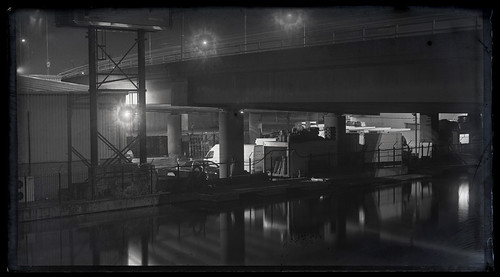 |
| HP3 plate, MPP Micro-Technical Mk VI with 16.5cm Tessar |
 |
| HP3 plate, MPP Micro-Technical Mk VI with 150mm Xenar |








Like the tall picture of scaffolding, very impressive. Why is stand developing so effective? And more questions, have you ever heard of Barnet Presstopan plates? I have some but have not had anything but black plates from them. How did you make the adapters to fit 5x4 darkslides?
ReplyDeleteThanks again for the comments. There was another vertical shot of the fairground which I accidentally spoiled the exposed plate by pulling out the wrong darkslide when setting up to shoot a different scene.
DeleteHow stand development works, as I understand it, is that with highly dilute developer (in itself low contrast), as it works on the highlights, the developer's action is restrained by the local build up of exhausted developer, or developer by-products, not dispersed by agitation, in effect keeping the highlights from blocking out, while shadow areas are able to develop to completion. This seems to be quite sympathetic to what might be either an over- or under-exposed latent image, although with the night shots I usually err on possible overexposure to get a usable negative.
I've not heard of Barnet Presstopan (I'm guessing a fast panchromatic plate for press work), the only Barnet plates I've used have been line tone plates, hideously fogged: http://www.flickr.com/photos/nicholasmiddleton/8976768992/
I did think about illustrating the adaptors; these were made from two pieces of mountcard, one to the size of 4x5 plate with a hole cut to the size of the smaller plate, and a second with a slightly smaller aperture glued on top to hold the plate in place.
Also, with the crane shot, there's actual solarisation (as opposed to the Sabattier effect, which typically gets called solarisation): the lights have turned black, something I've had happen with one or two other shots on glass plates with light sources in the frame.
Delete